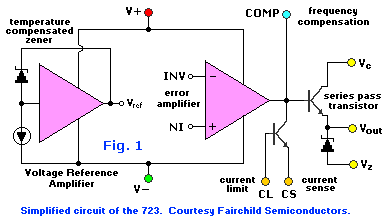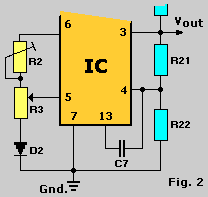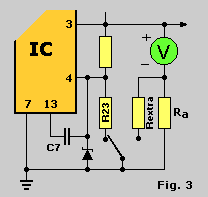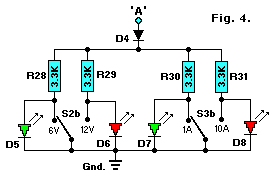
Bench
Top Power Supply -- Part 1.
© Tony van Roon, VA3AVR
"This 30 volt Bench Top Power Supply is rated at 10 amp, and it
is so versatile and powerful that it will slowly turn your regular 115VAC power drill. It was designed to work under
the most extreme circumstances and short-circuit protected (within specs), even in the 10-Amp setting. Cooling
(optional) fan(s) keep the semiconductors and the large cooling rib cool automatically."
 Introduction:
Introduction:
This "jumbo" power supply is built around the monolithic volt regulator IC from Motorola, the MC1723, which is a more
modern version of the old uA723 from Fairchild Semiconductors. Other versions of this IC, like the LM723 from
National and others, and even the old MC723 metal-can will work too. Though the prototype of this powersupply used the
ceramic military version of the 723. The uA723 voltage regulator was designed by Bob Widlar and first introduced in 1967, and used
ever since. It is a flexible, easy-to-use regulator with excellent performance. Looking at Fig. 1.,
this 14 pin regulator is not of your average type. You find this regulator everywhere, in a variety of applications
including military. This IC can function both as a positive or negative voltage regulator and designed
to deliver a load-current of 150mA DC. With external 'pass' transistors the output current can be increased to
significant levels, as in our project to about 10 amps (depending on your transformer). A special temperature
monitoring circuit (optional) will activate two to four CPU fans (optional) automatically if the temperature of the
large cool rib exceeds an adjustable temperature and activate or deactivate the fans within a 2.3°C temperature
variation. Pretty good for a 'cool' rib in my opinion. Even at 1 amp the cool rib may get warm, but at 10-amp
it gets really hot and so the fans will not only keep the temperature at a safe level it also is an added safety
feature to give this powersupply a life-span of at least 30 years! The semiconductors in the shaded, light yellow
area on the Circuits Diagram below go all on the large cool rib. See Fig. 5.

 Voltage Output in 'Low' setting is variable from 0.7 - 6 volts (more later why the 0.7V), in the 'High' setting the
voltage is variable from 3 - 30 volts. Current is adjustable in the 'Low' position from 0 - 1 amp and in the 'High'
setting from 1 to 10 amps. 0.1% line and 0.03% load regulation. Ripple is less than 0.001Vpp. Scale tolerance Low:
0.2%, High: 0.5%. Another welcome feature is the short-circuit protection. Beautiful chip. The normal commercial
temperature range is 0°C to 70°C (MC1723CD, CL, CG, and CP package). The military version (MC1723G or L) can
handle a temperature range of -55°C to +125°C. That one you can really freeze or cook!
Voltage Output in 'Low' setting is variable from 0.7 - 6 volts (more later why the 0.7V), in the 'High' setting the
voltage is variable from 3 - 30 volts. Current is adjustable in the 'Low' position from 0 - 1 amp and in the 'High'
setting from 1 to 10 amps. 0.1% line and 0.03% load regulation. Ripple is less than 0.001Vpp. Scale tolerance Low:
0.2%, High: 0.5%. Another welcome feature is the short-circuit protection. Beautiful chip. The normal commercial
temperature range is 0°C to 70°C (MC1723CD, CL, CG, and CP package). The military version (MC1723G or L) can
handle a temperature range of -55°C to +125°C. That one you can really freeze or cook!
Voltage Regulation:
Shown in Fig. 2. was the initial idea of voltage regulation and method we will be using. As
mentioned before there are two scales, 0.7 to 6 volts and 3 to 30 volts. A nice problem way to do that is with a
DPDT switch (S2). Plus we will add a Led to indicate which scale we are on. This toggle-switch switches both the
volt-scale and the volt-meter. In Fig. 3. you can see how, by putting one side of S2 to
ground via one resistor, the output voltage is in the 3 - 30V scale, and the other side of S2 via another resistor
(R-extra) to switch to the 0.7 - 6 V scale. At the same time we switch a parallel resistor with it as a shunt for the
panel-meter. If we calculate the value of this resistor to represent the meter Ri for the 6V scale, then
everything is a piece-of-cake. A single pole switch is in this scenario sufficient, without limiting any performance.
A second pole is used to switch the led-indicators, making S2 a double-pole-double-throw type. The 'Voltage' on the
front panel is controlled with potentiometer R3 and the scale adjusted with trimmer pot R2.
 The Led indicators have a voltage of between 1.8 and 2.0 volts dc
and the current no more then 25mA max. They can also use be used to glow on AC, only then an extra diode will be
required (see Fig. 4.) which also protects the Led's just in case we accidentally connect them the wrong way. Point
'A' is connected to the same as indicated on the circuit diagram. Leds D6 & D8 are for the 30-volt and 10-amp
respectively and D5 & D6 are the 6-volt and 1-amp settings but are not lit because they are shorted by the switch
S2b and S3b. Resistors R28 to R31 are chosen accordingly to input voltage. A rule of thumb is about 100 ohms per
volt input voltage. This means a little less than 10 milliamps per Led and that is enough to light them up. Depending
on the Led type you use (regular, high-, or ultra brightness) you may have to adjust these resistors to suit your needs.
You could use trimmer pots instead of resistors but that is such an overkill and waste. So, not needed, just a bit
of tinkering may be required. The method of short circuiting the unused leds was chosen since this was the simplest
and cheapest way of going about it. They also serve as a "On/Off" indicator of the power supply when it is switched
on because a minimum of two led's will always be on. It is okay to use two bi-color leds but they are more expensive.
The Led indicators have a voltage of between 1.8 and 2.0 volts dc
and the current no more then 25mA max. They can also use be used to glow on AC, only then an extra diode will be
required (see Fig. 4.) which also protects the Led's just in case we accidentally connect them the wrong way. Point
'A' is connected to the same as indicated on the circuit diagram. Leds D6 & D8 are for the 30-volt and 10-amp
respectively and D5 & D6 are the 6-volt and 1-amp settings but are not lit because they are shorted by the switch
S2b and S3b. Resistors R28 to R31 are chosen accordingly to input voltage. A rule of thumb is about 100 ohms per
volt input voltage. This means a little less than 10 milliamps per Led and that is enough to light them up. Depending
on the Led type you use (regular, high-, or ultra brightness) you may have to adjust these resistors to suit your needs.
You could use trimmer pots instead of resistors but that is such an overkill and waste. So, not needed, just a bit
of tinkering may be required. The method of short circuiting the unused leds was chosen since this was the simplest
and cheapest way of going about it. They also serve as a "On/Off" indicator of the power supply when it is switched
on because a minimum of two led's will always be on. It is okay to use two bi-color leds but they are more expensive.
Part 2 - of this project will start with the construction of the large cool rib,
mounting and wiring up all semiconductors, and (optionally) the cooling fans. Then the back panel and the 115VAC
wiring of the on/off switch, transformer, fuse holder and powercord/receptacle, and last the bridge rectifier BR1
and the large electrolytic capacitor C3. There are lots of photographs and pictures to help you get through all
this. The Printed Circuit Board and Lay-out are also available in Part 2. The finished product is a worth while
project and outperforms many commercial units.

Click here for a full size version in horizontal view. Only the diagram above prints
correctly though.
Back to Circuits Page or Continue to Part 2
Copyright © 2002, Tony van Roon
Last Updated: September 25, 2010


 Introduction:
Introduction:
 Voltage Output in 'Low' setting is variable from 0.7 - 6 volts (more later why the 0.7V), in the 'High' setting the
voltage is variable from 3 - 30 volts. Current is adjustable in the 'Low' position from 0 - 1 amp and in the 'High'
setting from 1 to 10 amps. 0.1% line and 0.03% load regulation. Ripple is less than 0.001Vpp. Scale tolerance Low:
0.2%, High: 0.5%. Another welcome feature is the short-circuit protection. Beautiful chip. The normal commercial
temperature range is 0°C to 70°C (MC1723CD, CL, CG, and CP package). The military version (MC1723G or L) can
handle a temperature range of -55°C to +125°C. That one you can really freeze or cook!
Voltage Output in 'Low' setting is variable from 0.7 - 6 volts (more later why the 0.7V), in the 'High' setting the
voltage is variable from 3 - 30 volts. Current is adjustable in the 'Low' position from 0 - 1 amp and in the 'High'
setting from 1 to 10 amps. 0.1% line and 0.03% load regulation. Ripple is less than 0.001Vpp. Scale tolerance Low:
0.2%, High: 0.5%. Another welcome feature is the short-circuit protection. Beautiful chip. The normal commercial
temperature range is 0°C to 70°C (MC1723CD, CL, CG, and CP package). The military version (MC1723G or L) can
handle a temperature range of -55°C to +125°C. That one you can really freeze or cook!  The Led indicators have a voltage of between 1.8 and 2.0 volts dc
and the current no more then 25mA max. They can also use be used to glow on AC, only then an extra diode will be
required (see Fig. 4.) which also protects the Led's just in case we accidentally connect them the wrong way. Point
'A' is connected to the same as indicated on the circuit diagram. Leds D6 & D8 are for the 30-volt and 10-amp
respectively and D5 & D6 are the 6-volt and 1-amp settings but are not lit because they are shorted by the switch
S2b and S3b. Resistors R28 to R31 are chosen accordingly to input voltage. A rule of thumb is about 100 ohms per
volt input voltage. This means a little less than 10 milliamps per Led and that is enough to light them up. Depending
on the Led type you use (regular, high-, or ultra brightness) you may have to adjust these resistors to suit your needs.
You could use trimmer pots instead of resistors but that is such an overkill and waste. So, not needed, just a bit
of tinkering may be required. The method of short circuiting the unused leds was chosen since this was the simplest
and cheapest way of going about it. They also serve as a "On/Off" indicator of the power supply when it is switched
on because a minimum of two led's will always be on. It is okay to use two bi-color leds but they are more expensive.
The Led indicators have a voltage of between 1.8 and 2.0 volts dc
and the current no more then 25mA max. They can also use be used to glow on AC, only then an extra diode will be
required (see Fig. 4.) which also protects the Led's just in case we accidentally connect them the wrong way. Point
'A' is connected to the same as indicated on the circuit diagram. Leds D6 & D8 are for the 30-volt and 10-amp
respectively and D5 & D6 are the 6-volt and 1-amp settings but are not lit because they are shorted by the switch
S2b and S3b. Resistors R28 to R31 are chosen accordingly to input voltage. A rule of thumb is about 100 ohms per
volt input voltage. This means a little less than 10 milliamps per Led and that is enough to light them up. Depending
on the Led type you use (regular, high-, or ultra brightness) you may have to adjust these resistors to suit your needs.
You could use trimmer pots instead of resistors but that is such an overkill and waste. So, not needed, just a bit
of tinkering may be required. The method of short circuiting the unused leds was chosen since this was the simplest
and cheapest way of going about it. They also serve as a "On/Off" indicator of the power supply when it is switched
on because a minimum of two led's will always be on. It is okay to use two bi-color leds but they are more expensive.